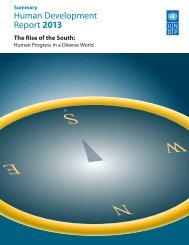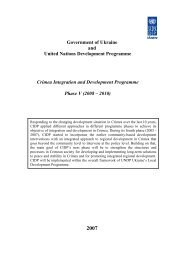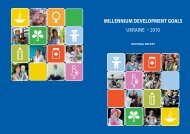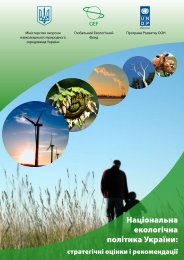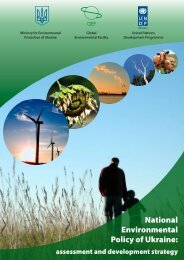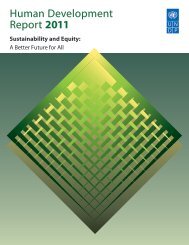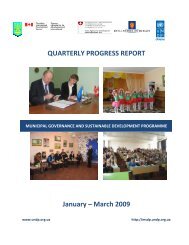E N S W - United Nations Development Programme
E N S W - United Nations Development Programme
E N S W - United Nations Development Programme
Create successful ePaper yourself
Turn your PDF publications into a flip-book with our unique Google optimized e-Paper software.
3.6 India’s Supreme Court issues a progressive verdict mandating seats for<br />
disadvantaged children in private schools 79<br />
3.7 Bangladesh makes dramatic advances in child survival 81<br />
3.8 Strengthening social protection in Turkey 83<br />
3.9 Conditional cash transfer programmes and Mexico’s Oportunidades 84<br />
3.10 Why New York City looked South for antipoverty policy advice 85<br />
4.1 Why population prospects will likely differ in the Republic of Korea and India 88<br />
4.2 China and Ghana: who benefits from the demographic dividend 100<br />
5.1 The shifting line between public and private in transportation 106<br />
5.2 A world parliament for global democracy 112<br />
5.3 Regional finance in Asia: Chiang Mai Initiative Multilateralization and the<br />
Asian <strong>Development</strong> Bank 114<br />
5.4 CAF: a Latin American development bank 115<br />
Figures<br />
1 Acceleration of growth on the HDI 12<br />
2 More than 40 countries of the South had greater gains on the HDI between<br />
1990 and 2012 than would have been predicted from their previous<br />
performance on the HDI 12<br />
3 Brazil, China and India combined are projected to account for 40% of global<br />
output by 2050, up from 10% in 1950 13<br />
4 The middle class in the South is projected to continue to grow 14<br />
5 The exponential rise in Internet use in the South has been most notable over<br />
the past decade 15<br />
6 At least 15 developing countries have substantial trading relationships with<br />
more than 100 trade partners as both exporters and importers 16<br />
7 Official foreign exchange reserves by country group 18<br />
1.1 Income per capita is rising to varying degrees in all four HDI groups 26<br />
1.2 Sub-Saharan Africa has sustained income growth over the last decade 26<br />
1.3 The lower the HDI value, the larger the gap between income poverty and<br />
multidimensional poverty 29<br />
1.4 There is notable variation among countries in the gap between income<br />
poverty and multidimensional poverty 30<br />
1.5 Losses due to inequality in HDI and its components 31<br />
1.6 Most regions show declining inequality in health and education and rising<br />
inequality in income 32<br />
1.7 Few countries show both the high HDI and low ecological footprint required<br />
for sustainable human development 35<br />
1.8 <strong>Development</strong> is not always accompanied by a rise in military spending 40<br />
2.1 As a share of world merchandise trade, South–South trade more than tripled<br />
over 1980–2011, while North–North trade declined 46<br />
2.2 Foreign direct investment flows to and from the South have veered sharply<br />
upward since the 1990s 47<br />
2.3 Between 2000 and 2010, Internet use grew more than 30% a year in around<br />
60 developing countries 50<br />
2.4 Export earnings per capita and human development are highly correlated 52<br />
2.5 Current foreign direct investment is positively associated with achievements<br />
in health and education in previous years 53<br />
2.6 Emerging market economies have amassed large foreign exchange reserves<br />
since 1995 58<br />
3.1 Some countries have performed well on both the nonincome and the income<br />
dimensions of the HDI 63<br />
3.2 Current HDI values and previous public expenditures are positively correlated . . . 71<br />
3.3 . . . as are current child survival and previous public expenditure on health 71<br />
4.1 Under the fast track scenario, education outcomes are enhanced 92<br />
4.2 In most countries, employment opportunities have not kept pace with<br />
educational attainment 93<br />
4.3 At each HDI level, some countries have greater carbon productivity than others 94<br />
4.4 Different environmental scenarios have different impacts on extreme poverty 96<br />
4.5 Education policies can alter dependency ratios 98<br />
4.6 Populations are ageing more rapidly in developing countries 101<br />
4.7 Human development prospects for 2050 are greater under the accelerated<br />
progress scenario, especially for low HDI countries 101<br />
4.8 Human development outcomes through 2050 improve more under the<br />
accelerated progress scenario 102<br />
4.9 Advances in GDP per capita through 2050 are especially strong under the<br />
accelerated progress scenario 103<br />
5.1 Under the accelerated progress scenario, the largest projected increases in<br />
the Human <strong>Development</strong> Index are in Sub-Saharan Africa and South Asia 118<br />
5.2 Allocating a small fraction of the international reserves of the nine G20<br />
countries of the South could provide substantial additional resources for<br />
public investment in infrastructure in Sub-Saharan Africa and South Asia 118<br />
Maps<br />
1.1 There is a small negative connotation between homicide rates and HDI values 39<br />
2.1 Thailand’s export expansion, 1995–2011 45<br />
Tables<br />
1.1 HDI and components, by region and HDI group, 2012 25<br />
1.2 Top five countries that rank better on the HDI than on gross national income<br />
per capita in 2012 27<br />
1.3 Inequality and satisfaction with freedom of choice and community 38<br />
2.1 Least developed countries’ trade with China, 2000–2001 and 2010–2011 46<br />
2.2 Different models of development partnerships 56<br />
3.1 Selected developing countries that registered large reductions in HDI shortfall<br />
or high rates of growth in gross national income per capita, 1990–2012 64<br />
3.2 Share of world exports of goods and services of high achievers in human<br />
development, 1985–1990 and 2005–2010 75<br />
4.1 Under-five mortality rate and total fertility rate by mother’s education level 89<br />
4.2 Projected number of deaths of children under age 5, by education scenario,<br />
2010–2015, 2025–2030 and 2045–2050 90<br />
4.3 Population in extreme poverty under the environmental disaster scenario,<br />
by region, 2010–2050 96<br />
4.4 Trends in dependency ratios, selected countries, 1970–2050 99<br />
4.5 Number of people in extreme poverty by region and selected countries, base<br />
case and accelerated progress scenarios, 2010–2050 103<br />
Contents | ix



